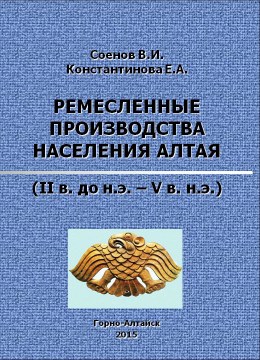 В.И. Соёнов, Е.А. Константинова
В.И. Соёнов, Е.А. Константинова
Ремесленные производства населения Алтая
(II в. до н.э. — V в. н.э.).
// Горно-Алтайск: ГАГУ. 2015. 248 с. ISBN 978-5-91425-118-2
См. файл на academia.edu.
Оглавление
Введение. — 4
Глава I. Технологии ремесла на Алтае в гунно-сарматское время. — 11
1.1. Деревообработка. — 12
1.2. Косторезное дело. — 32
1.3. Металлообработка. — 44
1.4. Стекловарение. — 57
1.5. Обработка камня. — 61
1.6. Текстильное производство. — 64
1.7. Кожевенное производство. — 70
1.8. Керамическое производство. — 76
Глава II. Условия формирования и развития ремесленных производств. — 88
Заключение. — 99
Приложения 1-7. — 109
Список источников и литературы. — 216
Список сокращений. — 245
Soenov V.I., Konstantinova E.A.
CRAFT PRODUCTION OF THE POPULATION OF THE ALTAI ^
(II century B.C. — V century A.D.).
Gorno-Altaisk: GASU. 2015.
Summary
This monograph deals with the analysis craft activities of population of the Altai at Hun-Sarmatian time on the basis of the study of archaeological sources. The paper presents analysis results of some technological aspects of woodworking and metalworking; boneworking and jeweller’s craft; textile craft, potter’s craft and leather industries; stone processing; glass melting.
Also in the work the conditions of formation and development of craft production in the Altai at the end of the I millennium BC — the first half of I millennium AD. The technologies processing of leather and skins, spinning of yarn and the weaving of the population of the Altai at Hun-Sarmatian time were at the same level as the previous period (Pazyryks culture). Obviously this is due mainly with natural forms of production of goods from these materials, what fully cover a requirement of the family, as is also the import of Chinese silk. Study of the processing of other materials showed emergence of a technological innovations. Primarily occurred a transition from bronze to iron tools. In addition, there were a change in the set of tools: arose many kinds of specialized hand tools. The ancient craftsmen used in wood processing, metalworking, boneworking and jeweller’s craft: adze with not closed sleeve, variety of cutters and drills, files, etc., which were not at Pazyryk time. In Hun-Sarmatian time the part of the population of the Altai used a potter’s wheel for the create of ceramic vessels. Thus, in these branches of craft already occurred specialization, which appropriate to a high level of handicraft production.
|